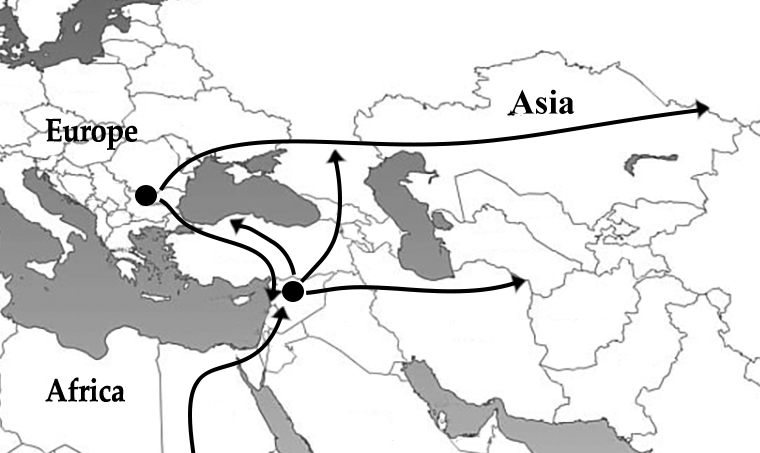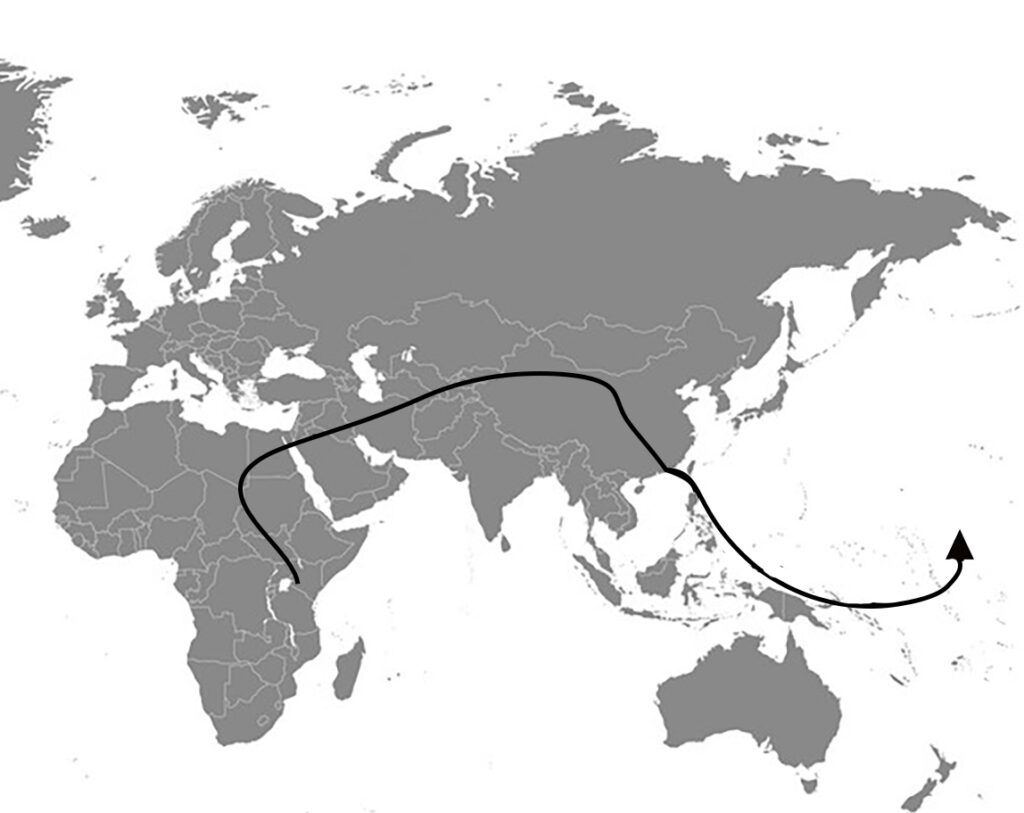5) Out of Africa
50,000 BC – How far back can we go?
Back to Africa where it all began. To the land where the earliest remains of human-like creatures were found, dating back to at least two million years ago. These creatures were the first that walked upright, but they looked more like apes than the humans we know today. Their brain was barely half the size of the human brain today, and they eventually went extinct.
Neanderthals were another step forward; they spread out to the Near East and Europe about 400,000 years ago. The discovery of some grave sites and the caves they lived in shows that they could make simple stone tools by chipping away at rocks. We don’t know whether they spoke or how strong their thinking ability was, but we do know that they took care of their sick and carefully buried their dead. The very simple jewelry they made from the talons of eagles suggests that they had some appreciation of symbolism. Before they died out, some of these Neanderthals migrated as far as what is now Russia. Some intermarried with a new group of humans that was just beginning to evolve. But in the end, the Neanderthals simply didn’t have the tools or the brainpower to survive.
Then, about 150,000 years ago, a new species evolved, one that we can all consider our true ancestral people. Homo Sapiens, “Intelligent Human,” is the name given to this new creature who shares our human traits and has passed on to us its genes. From the very start this creature began making crude tools, discovered how to light fire, and hunted in bands before retreating to caves or other shelters for protection from wild animals and the weather. That might not seem like much to us today, but it was just the beginning of their growth curve.
Gradually they developed the use of language. Not the distinctive calls that many animals have to warn others of the presence of a lion or an elephant, or to alert them to the presence of drinking water nearby. But a language rich and deep enough to allow them to tell stories of what happened to them that day as they gathered around the campfire in the evening. The language they shared allowed them to bond with one another more deeply and more widely so that they could travel in even larger groups. With their language came the power of imagination. For the first time, an animal species could imagine things that they had never seen, as we know from the paintings they left on the walls of caves and from the strange figures they carved from bone.
These accomplishments might seem modest to us, but the best was still to come. Their descendants, many thousands of years later, would split the atom, invent the computer, and map their own bodily genes, so leading us a deeper understanding of where we came from.
The new human species spent 100,000 years in Africa polishing their skills before they left Africa with their advanced tool kit about 50,000 BC. That last date is important, because it was then that this people burst forth from Africa into different parts of the world.
Some of them went to Europe, while others traveled east into Asia. A few made it all the way across Siberia where they moved across a land bridge into North America. Those groups that had moved north into Europe may have lived there for many generations, but most were later forced to retreat because of the cold and ice brought on by the first Ice Age. Eventually they returned to Europe and became the founders of early European communities.
Meanwhile, other groups wandered through Asia along two major routes: one south into India, and another northeast into mainland Asia. The wanderings of these early tool-makers eventually brought them into what is now Southeast Asia. Since they arrived during the Ice Age, they could have practically walked into Australia, where they became the first settlers, known as the Aborigines.

The sea level had greatly dropped because so much of the water had frozen into glaciers that extended well into continental Europe, Asia and North America. With the fall in sea level, the Sunda continental shelf was exposed. It formed a land bridge extending throughout Southeast Asia and practically into western Melanesia. The shelf linked the Malay Peninsula with Sumatra, Java, Bali and Borneo–and almost Papua New Guinea.
Travelers looking for new lands to settle didn’t have to be ocean-going voyagers to move into nearby Pacific Islands at that time. They could have paddled the short distance needed to reach the western tip of Melanesia. That is just what they did, as the first human settlers moved into the closest parts of that island group.

Even without reliable sailing craft, the people who had left Africa 50,000 years ago made it all the way to the Pacific. Many thousands of years later, others who possessed good canoes and dependable sailing techniques would follow. From there it was just a matter of time before they moved much further out into the expanse of the ocean and found their way to the islands we call home.
Conclusion
That’s the story of the grand journey that began in Africa and brought people to the shores of island Micronesia. During the long journey there were many detours, retracing of steps, and what might have looked like dead ends. Then, too, there is the mingling with other peoples along the way. But let’s not get confused in the details. We could never keep remember it all. Even if we did, the story would never end. The kids sitting around that kerosene lamp would never get to bed.
What you’re read here is the big picture, as far as we can reconstruct it today. But remember that there are still lots of question marks and a few blank pages in this. We have to work hard to recover the history of our people, and that work is still going on today.
So when someone asks where you came from, you’ll be able to tell a story that goes back further than your family genealogy, back beyond the foreign powers that once raised their flags over the islands, back beyond the arrival of Soukachaw or even Sapwikini or any other of the other founders we hear about in the old legends. You’ll be able to trace your roots all the way back to Africa.
Remember that the purpose of this story, like so many of the others we tell, is to help us understand who we are.

Credits
A few years ago, as I was working on a video documentary of the first settlement of the Mariana Islands, I was fortunate enough to meet Mike Carson and Peter Bellwood. Our discussions awakened a personal interest of mine in the history of the islands before the written documents and the legends that we have at hand. Both have written extensively on the subject, Mike tracking the coming of the first humans into Micronesia and Peter exploring the origins of the Austronesian family. Hiro Kurashina, retired professor at University of Guam, added thoughts on Indonesian influence to the discussion.
Ken Rehg, formerly on the faculty at the University of Hawaii, offered insights on the relationship of the Micronesian languages to one another and the impact of Polynesian tongues on some of the eastern Caroline Islands. Glenn Petersen’s overview of the area, Traditional Micronesian Societies, explored the ancient links between island groups. Don Farrell and Scott Russell, authors of histories of the Marianas, gathered considerable research materials and summarized their findings in a readable form. I have used some of their illustrations in this booklet. Tim Smit, who wrote a Micronesian history textbook, provided other maps and illustrations that I drew on.
Dozens of others have written helpful articles on different aspects of the early history of the Pacific and its ties to mainland Asia. I tried to absorb this material and incorporate the best of it into this simple–perhaps too simple–booklet. David Reich’s book, Who We Are and How We Got Here, was especially helpful for my synthesis here. I am indebted to the book for several of the maps used to explain the early origins of those who settled in the islands.
The Micronesian Seminar photo collection was the source of most of the photos used in this booklet as well as the map drawn from the information of those island navigators who had drifted to the Philippines in 1696.
I am grateful to all these scholars along with all the others, too many to acknowledge, who provided the sources for this work. As for this brief history, my fond hope is that it will open a door to the rich early history predating the first settlement of the islands. If it does this, I’ll be satisfied.
This is the introduction of a five-part series of posts on Micronesian Origins. The full list of posts are available below. You may also browse or download the PDF below.
- Introduction – Micronesians: Where Did They Come From?
- Ch 1) Back to the First Settlement of Our Islands (2,000 years ago)
- Ch 2) Where the Original Settlers Come From (1400 BC – 200 BC)
- Ch 3) The Beginning of the Seafarers (2500 BC-1400 BC)
- Ch 4) Through China to Taiwan (5000 BC-2500 BC)
- Ch 5) Out of Africa (50,000 BC)

